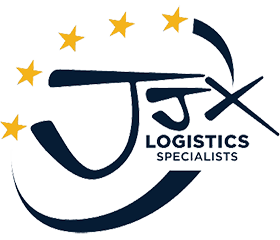Radioactive materials play a vital role in various industries, including healthcare, research, and energy production. From medical diagnostics and cancer treatments to scientific advancements and power generation, these materials have proven indispensable.
However, the transportation of radioactive goods requires meticulous planning, stringent regulations, and the utmost attention to safety measures. Helpfully, there are clear guidelines on how this applies to the road transport of these items from a number of global and regional organisations.
Where transport is essential, it's important to use an experienced ADR carrier for radioactive goods so consignors can be confident that the method of transportation and all personnel involved can ensure the safe transport of radioactive materials.
In this article, we delve into the critical aspects of safely transporting radioactive materials, exploring the challenges involved and the comprehensive systems in place to protect both people and the environment.
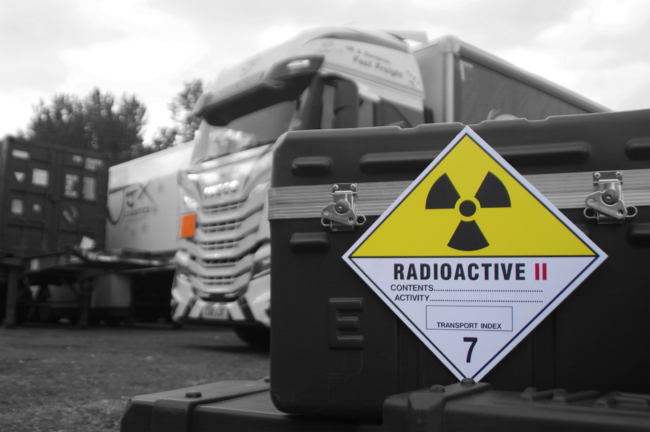
Definition of Radioactive Class 7 Materials
It’s critical to first understand what is classed as radioactive material, what class 7 materials are and how best to provide protection and security for radioactive materials in transit.
By definition, radioactive materials (radionuclides) contain unstable atoms as their nucleus. These substances can emit alpha, beta or gamma rays and damage living tissue when they penetrate the skin, thus being a risk to those handling or in the vicinity of the dangerous goods.
Class 7 materials are those which contain unstable isotopes of an element which is undergoing and emitting radiation. As a result, these substances differ from dangerous products classes 2 and 3 regarding storage, transportation limitations and packaging requirements.
Common Examples of Class 7 Radioactive Materials
So what are some examples of radioactive materials that are commonly transported? There are plenty to choose from, with research showing around 15 million packages of radioactive materials are transported by road, sea and rail every year. Contrary to what many may think and stated in the same study by the World Nuclear Association, around 95% of these packages are not directly related to nuclear power. Below are some of the most well known class 7 radioactive materials:
Radioactive materials such as technetium-99m or iodine-131 are used in medical diagnostic equipment such as X-ray machines or treatments.
Objects or materials that have radioactive contamination on their surface, which can pose risks if not handled properly.
Devices that use radioactive material, such as americium or caesium, to measure the density or thickness of materials.
Naturally occurring ores or minerals that contain radioactive elements, such as uranium or thorium.
Uranium that has a lower concentration of the isotope uranium-235, often obtained as a by-product of uranium enrichment. It is used in military applications.
A powdered form of uranium ore, used as a precursor for the production of nuclear fuel.
Radioactive waste generated during nuclear fission reactions, consisting of a mixture of various radioactive isotopes.
Categories of Radioactive Class 7 Materials and Labels
The categories of Radioactive Class 7 materials refer to a classification system used to identify substances that emit radiation. Goods are marked according to the levels of radiation they emit, ensuring proper handling and safety measures are in place.
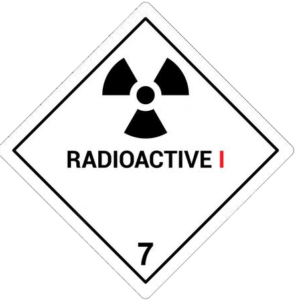
Class 7A: Category I White
This category comprises radioactive substances categorised as '7A'. These substances are identified by a maximum surface dose rate below 0.005 millisieverts per hour (mSv/h ). Packaging for these substances must display this information on the outside. While a transport code is not required, a specific hazard label must be visible and completed when shipping.

Class 7B: Category II Yellow
On the other hand, dangerous goods class 7B includes category II radioactive substances that expose individuals to external radiation, posing a significant risk, particularly for those who work with them. To minimise the risk to individuals, the exposure time for these substances must comply with ADR instructions. The surface dose rate for Group 7B ranges between 0.005 mSv/h and 0.5 mSv/h.
Unlike dangerous goods category 7A, category 7B must also specify the transport index (explained further on in this article), which cannot exceed 1. This category is commonly known as Category II-Yellow and is identified by a yellow hazard label.
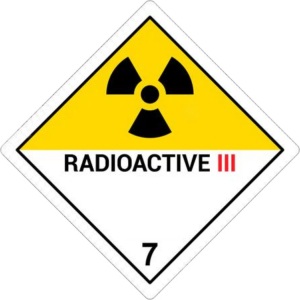
Class 7C & D: Category III Yellow
Categories 7C and 7D can be combined as Category III-Yellow, although they have different limits. For radioactive goods class 7C, the radiation dose can range between 0.5 mSv/h and 2 mSv/h. Similarly, there are restrictions on exposure time and hazards associated with substance ingestion. The transport index must not exceed 10.
Class 7D goes even further: the dose rate on the outside can be greater than 2 mSv/h, but should not exceed 10 mSv/h. In cases where substances and objects are transported with "exclusive use" and specific additional requirements, the transport index is not limited.
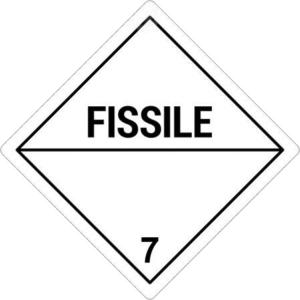
Class 7E: Fissile Materials
Category 7E includes fissile materials and as such has its own category. 7E goods have their own white hazard label, which includes the word "Fissile" and an additional safety note. Furthermore, the criticality safety index (CSI) must be indicated on the hazard label to differentiate category 7E from others.
Overview of the Safety Regulations and Procedures for Transporting Radioactive Materials
Below are some of the specifics of the safety regulations and procedures that must be adhered to concerning the transport of radioactive materials.
Preparing for Transport
In the first instance, all receiving sites must be authorised to receive the radioactive item and the volume being delivered. As the consigner, you should consult with the site before arranging shipment to confirm they have the correct permissions to hold such materials.
Determining a Transport Index for a Radioactive Package
The Transport Index (TI) number is used to inform about radiation exposure during transportation and helps alert personnel in the transport chain of potential hazards. When yellow package labels are necessary, a TI must be established and recorded on the label and in the relevant transport documents.
To determine the TI of a package, the ADR instructs carriers to measure the maximum radiation level at one metre from all the external surfaces of the package where applicable. Should this figure be in millisieverts per hour, and then multiplied by 100. Alternatively, the figure can be recorded in microsieverts per hour and divided by 10. Finally round the figure to the first decimal place to obtain your TI number - if the number is below 0.05 then it is recorded as zero.
| Transport Index (TI) | Maximum radiation level at any point on external surface | Package category | |
|---|---|---|---|
| In millisieverts p/h | In microsieverts p/h | ||
| 0 | <0.005 | <5 | I-White |
| >0 TI <1 | >0.005 n <0.5 | >5 n <500 | II-Yellow |
| >1 TI <10 | >0.5 n <0.2 | >500 n <2000 | III-Yellow |
| TI >10 | >2 n <10 | >2000 n <10000 | III-Yellow (Exclusive use) |
How to Safely Package Class 7 Materials
Class 7 materials should be packed with extreme care and follow all applicable legal guidelines and regulations set out by the Carriage of Dangerous Goods and Use of Transportable Pressure Equipment Regulations 2009 (CDG) Act.
Packaging must ensure the product is maintained and protected with minimal threat to consignors, transportation operatives, receivers and any other parties who come into contact with the radioactive materials.
It should be explicitly designed with shipment in mind to offer maximum protection and take into account acceleration, vibrations and braking. The external packaging should also be free from damage to avoid contamination. It also needs to be designed not to collect or hold water or contain features that will compromise its integrity.
Packaging can be in the form of:
- Bulk container systems
- Pressure receptacles and similar
- Smaller packages with inner receptacles
- Packages such as drums or corrugated packages up to 400 in weight or 450 litres
In terms of packing, this refers to all the items included in packing the materials, including the immediate package around the dangerous material, e.g. a glass jar and all associated materials used, including packing foam, tape to seal outer packing, cardboard boxes and labels.
All packages must bear the correct radioactive warning labels to alert others of the content of the package.
Proper Labelling and Documentation Requirements
Because radioactive materials are particularly hazardous to humans, the environment and wildlife, specific care must be taken during transportation. These actions include complete transit documents and appropriate packaging, labelling, documentation and qualified handling.
Several UN guidelines and binding mode-specific laws, including ADR (road transport), RID (rail transport), ADN/ADNR (inland waterway transport), IMDG Code (maritime transport) and ICAO-TI (air transport) outline all of these requirements. The following information must be included in the transport documents:
- The consignee's address
- The UN number
- The class of dangerous goods number (e.g. Class 7B)
- Name and general description of the radioactive material
- Information of radionuclides contained in the radioactive material
- Package category
- Package type
- Total radioactivity
- Physical state and chemical formula
- Transport index (TI) and (if applicable) the criticality index
- Marking of the approval authority (for packaging subject to approval)
Security Measures That Can be Implemented During Transport
Security and all parties in the shipping process should be a high priority at all times, from the consigner to the receiver. The carrier must know the role of transporting such goods and the security concerns they could encounter while transporting radioactive items.
A strong security system should include a combination of physical measures, proper procedures, and the commitment of both managers and employees. While the specific methods of physical security may vary depending on the location, some common features include:
- Physical and electronic security measures
- Alarm systems or CCTV
- Access control
- Personnel searches
Drivers and carriers should work to ensure that the correct protocols are followed when transporting and handling packages containing radioactive material. Personal protection equipment should be used where applicable, and proper handling techniques are always used.
On top of this, drivers should also be aware of the different security risks that can affect the cargo and be mindful of national security for each country they will be driving through before they set out.
For added security, it is advisable that the shipment is never left unattended, all windows and doors are kept closed and locked and that drivers have a method of communication in the event of an emergency or security breach, including a direct line to the police. The Department for Transport and ONR (Office for Nuclear Regulation) must be informed along with the local police department of any security breaches that occur during transit.
Importance of Monitoring During Transportation
As these volatile materials go through their lifespan, they are prone to change and unpredictability. There is the risk of damage from even the slightest change in the package; for this reason, careful and regular monitoring is required throughout the journey.
The degree of monitoring will depend solely on the type of goods being transported and the amount the consigner is shipping at once. If multiple packages contain more than one type of radioactive material, each package must be labelled individually and recorded so the driver knows the contents, the volume of the dangerous goods they are carrying and the correct protocols for safe handling and transportation. This allows for a more seamless transfer of goods and a reduced risk of complications arising from the movement of radioactive materials.
Potential Consequences of Mishandling Radioactive Goods
Failure to comply with guidelines and regulations can result in catastrophic results. Incorrect handling, sorting, packaging and driving techniques can render the radioactive packages dangerous and upset the unstable molecules. Below are just some of the possible consequences of mishandling a radioactive packages.
Radiation Exposure
Improper handling can lead to radiation leaks and exposure to the personnel involved in the transport, emergency responders, and the general public. This exposure can result in acute radiation sickness, long-term health effects, and an increased risk of cancer.
Environmental Damage
Radioactive materials, if not properly contained, can contaminate soil, water bodies, and ecosystems. This can harm plants, animals, and marine life, disrupting the natural balance and potentially causing long-term environmental damage.
Legal and Regulatory Consequences
Mishandling radioactive materials is a serious violation of regulations and can lead to legal consequences, including fines, penalties, and potential loss of licences or permits. The responsible party may also face civil lawsuits for damages caused.
Damage to Reputation
Mishandling radioactive materials can have severe reputational consequences for the organisations involved, including transport companies, regulatory bodies, and government agencies. This can lead to loss of public trust, negative media coverage, and long-term damage to the organisation's image.
Consigners, carriers and receivers must all be aware of the Carriage of Dangerous Good Regulations and to ensure complete compliance in accordance with ADR for the materials you will be storing and transporting.
Failure to comply can lead to severe consequences and potential harm. If you are unsure of any procedural requirements for your shipment in the first instance, you should contact the relevant government bodies to ascertain legalities and then work with an experienced carrier to facilitate the transfer of radioactive materials.
We're ready when you need us
